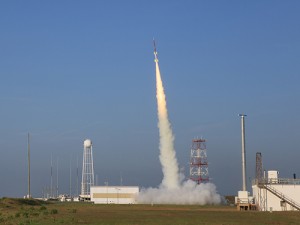
WALLOPS ISLAND — After a successful rocket launch at NASA’s Wallops Island Flight Facility along the Virginia shore just south of Assateague and Ocean City early Thursday, a second and larger of the two is expected to go up early Saturday morning with a launch that should be visible throughout the mid-Atlantic region.
A Terrier-Improved Orion sounding rocket containing multiple student-built experiments was successfully launched from NASA’s Wallops Island facility around 7:20 a.m. on Thursday, arching its way across the crystal clear early morning sky before falling harmlessly into the ocean. The launch was part of the facility’s annual Rock On workshops at Wallops, during which budding young student scientists and teachers from all over the country are invited to Wallops to participate in a series of lessons culminating with the launch of two rockets in three days.
The second launch, a suborbital Terrier-Improved Malamute sounding rocket is expected to go up between 4 a.m. and 5 a.m. on Saturday. The second launch, which is larger than the rocket launched on Thursday, is expected to visible in the pre-dawn hours on Saturday across a wide swath of the mid-Atlantic region from North Carolina to New Jersey along the coast and as far west as western Maryland and southern Pennsylvania.
During Saturday morning’s launch, NASA will be testing several new suborbital technologies with the hope of gaining a better understanding of the formation of clouds and storm systems and their relationship with the earth’s atmosphere. The rocket will launch natural earth metals such as barium and lithium, for example, which will vaporize in the atmosphere and create bright clouds of different colors.
Those clouds will then help researchers measure the velocity and direction of the wind in space. The brightly colored clouds may be seen by residents all over the mid-Atlantic region and might actually provide a better experience than the launch of the rocket itself.
The byproducts of releasing the burning metals into the atmosphere do not pose any health risks or environmental risks. For example, NASA officials said this week the amount of barium, lithium and other burning metals deployed during the rocket launch on Saturday will be much smaller than that used in a typical Fourth of July fireworks display.
